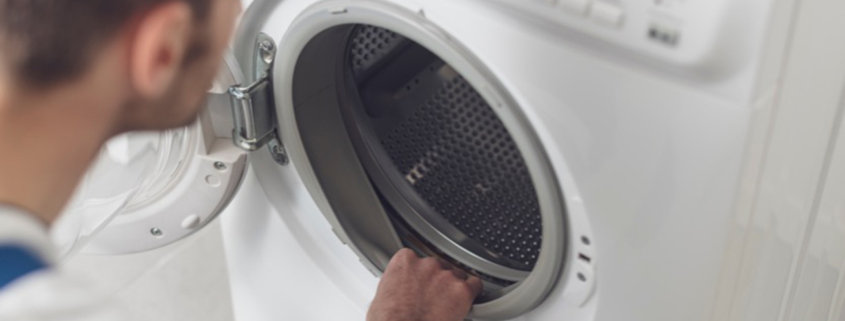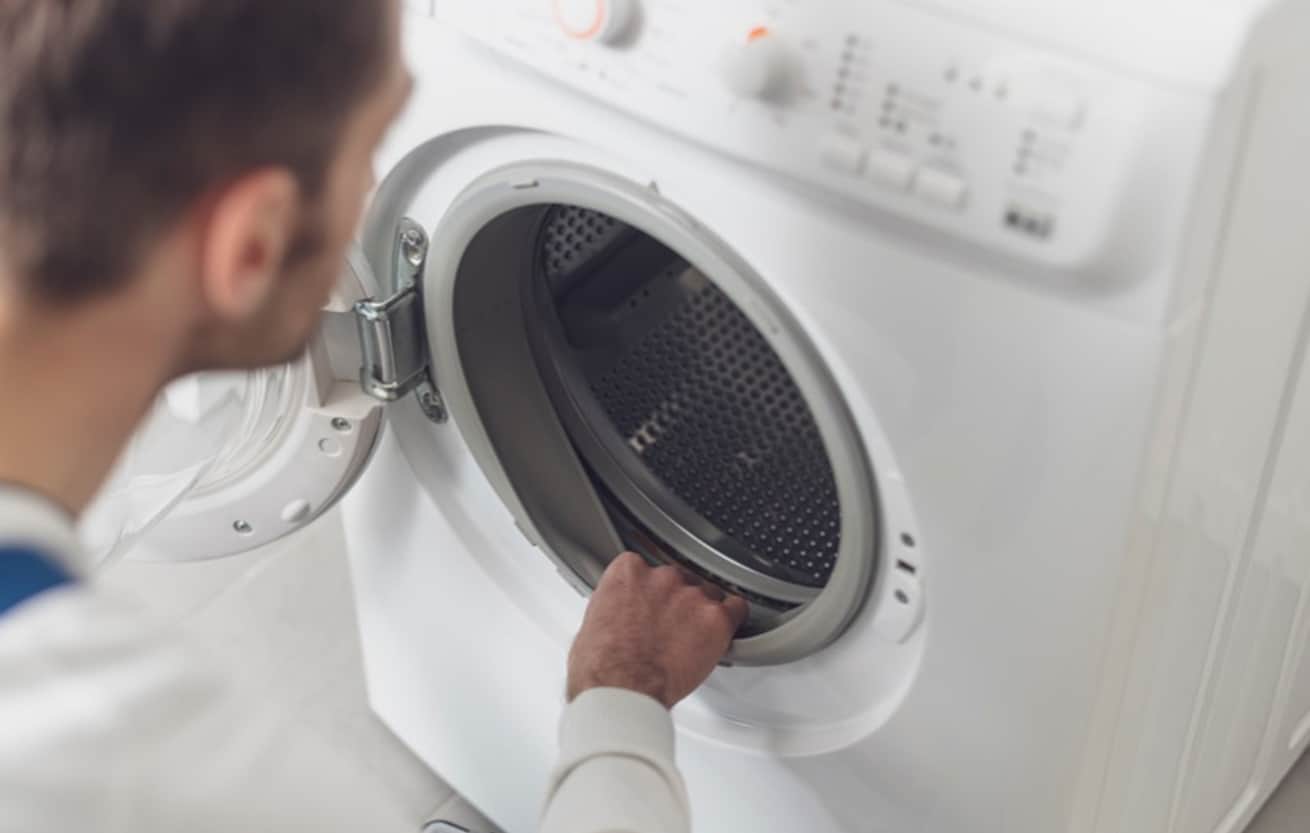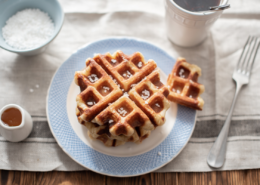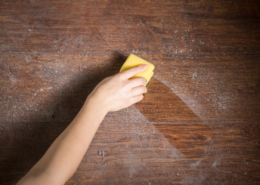How to Deep Clean a Washing Machine—Top and Front Loading (and Why You Should!)
If you assume the inside of your washer is the cleanest place in your home because you put detergent through it with every load of laundry, join the club. And that’s a really bad assumption. It’s time for us to learn how to clean a washing machine.
Have you ever wondered why there’s dirty residue on the agitator? Why do washed clothes sometimes come out with stains they didn’t have before they went in? Why do towels get stinky? Why you open the lid of the machine and get a waft of stink?
The answer is germs. According to a study by Dr. Charles Gerba, professor of microbiology at the University of Arizona, if you wash a load of just underwear, there will be 100 million E. coli in the wash water, which can be transmitted to the next load of laundry.
However, this is good to know—of the more than 60,000 germs, only one to two percent of them are potentially pathogenic. But the other 98 percent, when allowed to accumulate, can produce a terrible odor in clothes, towels, and linens—and inside the washer, too.
If you rely on laundry detergent alone to get rid of all the dirt and germs but are not occasionally using bleach and very hot water, you’re not killing the bacteria. In fact, they’re getting on your hands when you remove the wet laundry and also staying behind in the washing machine.
How to Clean a Washing Machine
You’ll need:
✅ rubber or latex gloves
✅ cleaning cloths
✅ old towels
✅ bucket or container for mixing
✅ plain white vinegar
✅ liquid chlorine bleach*
✅ hot water
If possible, turn up your water heater to at least 140 F. several hours before you clean your washer.
CAUTION
Professionals recommend keeping your water heater set at a temperature between 130 and 140 degrees Fahrenheit. Any higher or lower could be dangerous for you and your family.
While turning the temperature up higher can result in burns, turning it lower than the recommended setting can also be dangerous. In colder water temperatures, bacteria can form in the water heater tank. This could become a health risk for you and your family, potentially exposing you to health hazards such as Legionnaires’ disease.
This illness is a type of pneumonia and the bacteria that causes the illness can thrive in a water tank between the temperatures of 77 degrees and 113 degrees Fahrenheit.
Read the manual
Washing machine manufacturers almost always include a cleaning directive in the owner manual. My 9-year old GE front loader has a setting on the dial for “Clean Basket,” as do many newer washers. Start following the directions in your owner manual if you have such a setting. Or these general instructions:
Front-Loading Washing Machine
This is a multi-step process, which should be performed monthly.
- Make sure the drum of the machine is completely empty—never include any items of clothes, towels or other while cleaning the machine. Select “Basket Clean” or “Tub Clean” on the wash settings. Select the hottest, largest, and longest load settings if your front loader does not have such a setting.
- Add 2 cups of white vinegar to the empty washer drum (or to the detergent reservoir if your machine does not have a “Basket Clean” or “Tub Clean” cycle). This will help eliminate the odors and any mildew that has accumulated inside the machine. Allow the machine to run through an entire wash and rinse cycle.
- Set the washer a second time on the same cycles as above—“Tub Clean,” or “Basket Clean,” or the hottest, largest and longest cycles. Pour 2 cups of liquid chlorine bleach into the empty washer drum. This is going to kill germs and bacteria that have accumulated inside the machine. Allow the machine to run through another entire wash and rinse cycle.
- Run a third cycle on the same cycle without adding anything to the empty washer drum. This will remove and rinse away any remaining residue.
- Fill a bucket with a solution of 1/4 cup liquid chlorine bleach and 1-quart water. Dip a clean rag into the solution, ring it out. Pull back the rubber seal around the washer door, looking for mildew and other deposits. Clean this area well with the rag or scrub brush, rinsing it as needed in the bucket. Follow with a clean, dry cloth to remove any remaining moisture from the seal area.
CAUTION
Never mix bleach and vinegar. Ever. Together they produce harmful toxic gas. The cleaning process above provides for these substances to go into the machine separately, followed by complete rinse cycles to clean out the reservoirs.
Top-Loading Washing Machine
This process is similar to cleaning a front-loading machine and should be repeated monthly.
- Making sure there are no clothes in the machine, set it to the hottest, largest, and longest cycle available. Add 4 cups (1 quart) of plain white vinegar to the tub (no detergent). Close the lid and allow the machine to agitate for one minute or so. Open the lid (or press “Pause”) so agitation stops and allow the machine to sit for one hour. After one hour, allow the machine to complete a full cycle including rinse and spin.
- Leaving the same settings, fill the machine with the hottest water available and add 4 cups (1 quart) liquid chlorine bleach. Close the lid and allow to agitate for one minute, then open the lid to stop the agitation for one hour.
- After one hour, allow the machine to complete a full cycle including rinse and spin, again.
- Run a third cycle on the same settings without adding anything to the detergent reservoir. This will rinse away any remaining residue.
- Finally, using a clean cloth dipped into a mixture of 1/4 cup liquid chlorine bleach to 1-quart water, clean the area under the rim of the washer—between the basket and machine’s housing. Wipe down the detergent reservoir and clean all of the nooks and crannies of the washer that you can reach easily, where bacteria and dirt may have accumulated.
*If you don’t want to use chlorine bleach, do not assume that oxygen-based bleaches or hydrogen peroxide will give you adequate disinfectant qualities needed for cleaning. PineSol in place of liquid chlorine bleach is an acceptable and effective substitute to clean your washer. And it is septic system safe. Follow the same steps for cleaning with chlorine bleach as listed above.
More
- Dingy Gray Laundry is the Problem—This is the Solution!
- How to Make the Best Homemade Liquid Laundry Detergent
- A Simple Solution for Gross, Smelly Towels
Published: 2-28-20; Updated 11-30-22
















I will never ever buy a front loader. We had them growing up in the 70s and the 80s and I hated them. My grandmother had them at her house too. I like the top loaders. They don’t leak, they don’t have to be cleaned as much, they take less time, and you can open them up if you forgot to put a sock in etc. My mothers used to take an hour to do a load and then the dryer wasn’t any better (and they were new) and it took an hour to dry clothes too and you had to empty the water out of it every few days.
Well, Patricia … this is rather irrelevant to knowing how to clean a washer, isn’t it? Modern front-loaders are a big change from the 70s and 80s.
I agree. My apologies. I still wouldn’t buy one. I used my mothers front loader in July and in October and November and I still wasn’t impressed with them. they are slow and take forever. They smell too where my front loaders never smell. LOL
I have a high efficiency washer that won’t fill up completely. Any suggestions? Thanks!
High Efficiency means it uses very little water. So not sure it’s supposed to “fill up completely!” Check your owner manual.
My 15 year old Maytag front loader was able to do this by setting it on hot, then adding the stain cycle, heavy wash, and extra rinse to add more minutes. Took all afternoon for all the steps, but WOW! This is so much cleaner than any “washing machine cleaner” I have tried running through it. Thank you!
I use Affresh washing machine cleaner tablets once a month. Is this an effective way to clean the front loader?
Affresh for front or top loading washing machines contains: Sodium Percarbonate, Sodium Carbonate, Glucono-Delta-Lactone, Polyethylene Glycol, Sodium Acetate, Fragrance. None of those ingredients are known to kill germs like E.coli.
I used Afresh in my top loader, and it did nothing. My washer still smelled as bad as it did before. I also used the vinegar and bleach method and it didn’t help either. But when I read this article, I realized that I hadn’t wiped the inner rim with bleach. So, I’ll start over and remember to wipe the rim this time.
We have a septic tank and can’t use bleach. Any suggestions?
My research says you can use bleach with a septic system. Here is just one expert directive on the subject from Septic Tank Pro: Can You Use Bleach in a Septic System? What’s the Harm? The Answer. There are others so I suggest you do your own independent research.
Mary, she’s right – For the first 40 years of my life I lived where we had a septic tank and we took good care of it – If you put very much bleach thru it – it will kill the bacteria that digest the solids (they have to be liquified to drain out into the septic drain field. (The only thing that should go to the septic tank is the drain from the stool – all other drainage from the house should bypass the septic tank) One of my aunts came to visit and she cleaned our toilet every day with bleach – by the time she went home the septic tank was backing up. My mom put in 2 or 3 batches of Septic Tank cleaner (it replaces the bacteria – but may take a week or two to get the septic tank working properly.
The only people I know who deal with septic tanks who say bleach won’t hurt them are the people who sell the septic tank cleaner (Rid-X is one brand) and the others are the “Honey Dippers” large trucks that clean out septic tank sludge (from septic tanks not maintained correctly)
Like many others, I have hard water where I live. I have always used CLR (Zep works fine, too) once a month to clean the washer for many, many years. Don’t remember where I learned that from, but it seems to work well. Also put some in the fabric softener dispenser at the same time. The directions are on the product label for washers, dishwashers and other items.
Great tip Jean. CLR is a fine product for removing calcium, lime, and rust deposits. But CLR does not kill bacteria and germs.
When we bought our front loading machine 18+ years ago I insisted it have the ability to heat water to 170-180 F (I’ve forgotten which). I had just read an article sponsored by Clorox that showed how much bacteria was left at least around the top of a top loading machine. I was also found that many front loading machine advised against using Bleach in their machines. ( I presumed this was because the machine holds about 1 quart of water after emptying.
It was a tough conversion as I grew up with always bleaching towels, sheets, and cotton underwear! And, yes towels faded but that wasn’t seen as a reason to avoid sanitizing towels! Now I can’t believe that nearly all bedding comes with labeling saying cold water or similar.
Won’t the bleach get rid of odors and mildew? Instead of having to first run a load w the vinegar?
Bleach is not effective against the hard water minerals, soap, and scum that build up in the hoses and gaskets of a washing machine. Vinegar is.
I’ve had a front loader for 16+ years. I started right away with a large scoop of baking soda and leaving the door open slightly. No smells or mold.
My front-load washer’s detergent dispenser will not hold 2 cups. Will the protocol work if I fill simply use as much as it will hold?
Thanks for your un-ending efforts to help us save money in so many ways!
Wondering the same bc neither will mine..
You don’t have to use all the bleach or vinegar in the dispenser. Add a half cup and put the rest directly into the tub itself is how I do it. I have a front loader.